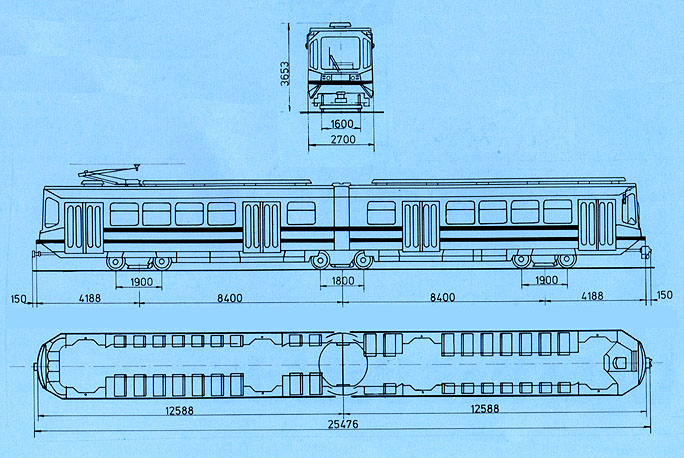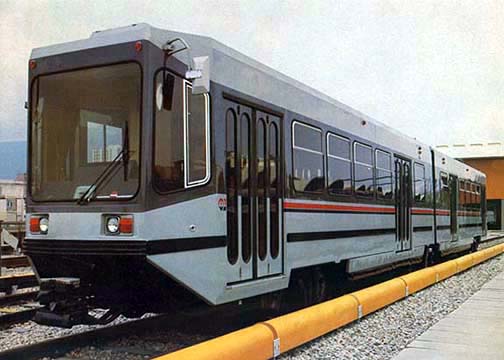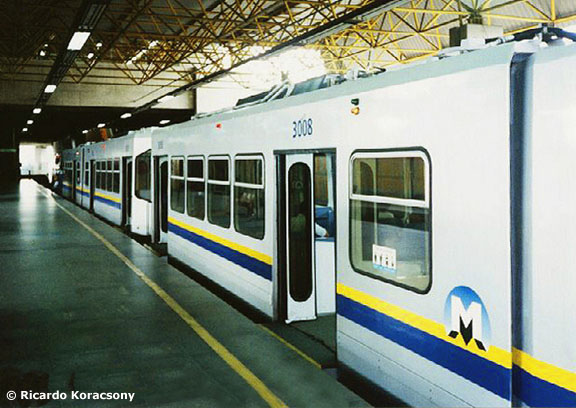Light Rail #1, 1982-1985 [see Light Rail #2, 2016-] Like the Santa Teresa tramway in the 1870s, Rio's "super tram" line of the 1980s was built along an aqueduct that brought drinking water from the mountains into town. Rio de Janeiro closed its last 1435 mm gauge tram line (Alto da Boa Vista) in 1967. (The 1100 mm gauge Santa Teresa system survived and still operates today.) In 1968 the city announced plans for (1) a large third-rail metrô system that would connect Copacabana with Tijuca and Maria da Graça; and (2) a light rail
or pré-metrô line that would draw power from overhead wires and connect Maria da Graça with Pavuna [see map].
As traffic increased, the latter would be upgraded to full metro. Both lines would have 1600 mm track gauge. Construction began in 1970 and Metrô Rio inaugurated the first section of its third-rail line, between Glória station and Praça Onze, in March 1979 [see map]. It began construction of its light rail line along Av. Automóvel Clube, which followed the abandoned Rio d'Ouro Railway that had been built in the 1870s to lay pipelines that brought water to the city. In 1977 it ordered 68 articulated light rail vehicles with pantographs from a consortium led by La Brugeoise et Nivelles ("BN") of Belgium and Companhia Brasileira de Materiais Ferroviários ("Cobrasma") of Brazil. The Belgian company published the illustrations below to show its new South American model:
[Rio's light rail vehicles and line were called pré-metrô
until 1991, when a similar line opened in Campinas
which that city's builders called "sistema VLT - veículo leve
sobre trilhos". The term "VLT" was used thereafter throughout Brazil,
including in Rio de Janeiro.] BN's Brazilian model had controls at
one end only, so the cars always ran
back-to-back, in pairs. Note also that the doors in the drawing and the
photo are designed for low platforms – street loading. They never
ran that way in Brazil. The doors
were rebuilt in Rio for high-level platforms [Metrô Rio]:
The
first two units, built by BN in Belgium, arrived in Rio de Janeiro in
January 1979 [photo above]. Six more cars came from Belgium that year,
and between
1980 and 1982 Cobrasma assembled 18 at its factory in São Paulo. Third-rail metro line 1 was extended from Praça Onze to Estácio in 1980 and part of metrô line 2, from Estácio to
Maracanã, opened in 1981 [see map]. At first, both lines used the same third-rail trains built by Mafersa in São Paulo. As ridership
increased Metrô Rio needed more trains for line 1, so
transferred the Mafersa units from line 2 to line 1 and altered some of the pré-metrô cars for use on line 2: doorwells
were rebuilt for high platform loading, steps were added outside each
door and the pantographs were replaced by third-rail shoes. A group of
modified units
went into service on line 2 on 18 May 1982. This was the first use of
the articulated pre-metrô – light rail – cars in Brazil, although they were running as metrô cars for high platforms and third-rail. The photograph below shows an articulated train
using third rail near São Cristóvão station in 1983. Note
the little steps below the doors, which have been raised from 65 cm
(25.6 in) to a meter (39.4 in) above the rail. Maracanã stadium
looms in the distance [AM]:
On 12 March 1983 line 2 was extended from Maracanã to Irajá in two sections – using third rail from Maracanã to Maria da Graça, and drawing power from overhead wires beyond [see map]. A group of articulated trains with third rail shoes ran from Estácio to Maria da Graça, and another group with pantographs ran from Maria da Graça to Irajá. This was the first time that these vehicles had run under wire, but they loaded from high platforms and Rio's "pré-metrô" plan had clearly lost its way. Rio resident Pedro Souza took the two photographs below in April 1984:
Cariocas disliked the walled-in railway that cut their communities in two. They hated the stairs they had to climb to reach it and the hot, un-airconditioned cars. (They had been spoiled by the airconditioned Mafersa trains on metro line 1.) Only two intermediate stations were open and trains ran only from 9am to 3pm! There was no service at all on some days – for example on Friday 26 October 1984 when the author tried to photograph the line. Operation stopped altogether after a pipeline broke in November 1985. At least that was the explanation of the authorities. Rio's "light rail" experiment had lasted 32 months. Metrô Rio removed the overhead wire and the grade crossings and rebuilt line 2 as 100% heavy metro, with third rail, from Maria da Graça to Irajá. Five more cars arrived from Cobrasma in 1986, completing a fleet of 31, numbered 3001-3031, all airconditioned and remodeled for high platforms and third rail. Metro line 2 reopened in 1987 and finally reached Pavuna, 22 km from Estácio, in 1998 [see map]. Ricardo Koracsony took the following photographs of rebuilt articulated trains at an unidentified station in February 2001:
[As Metrô Rio was building its extension to Pavuna, the city of Campinas in São Paulo state acquired six similar cars from Cobrasma – a model that it called "veículo leve sobre trilhos" – and opened an 8 km line in 1993. The Campinas VLT closed in 1995.] Rio's 31 articulated cars – 8 Belgian and 23 Brazilian – were removed from service about 2007. About 2012, 28 of them were placed in a vacant space alongside the Viaduto dos Marinheiros, near the west end of Av. Presidente Vargas. They are still there today [Google Earth 3D view 2018]: |

(Until the 1960s the space occupied by the highway junction and apartment buildings at the west end of Av. Presidente Vargas – shown above – was occupied by the Vila Isabel shops and yard of the Rio de Janeiro Tramway Light & Power Company.)

|





